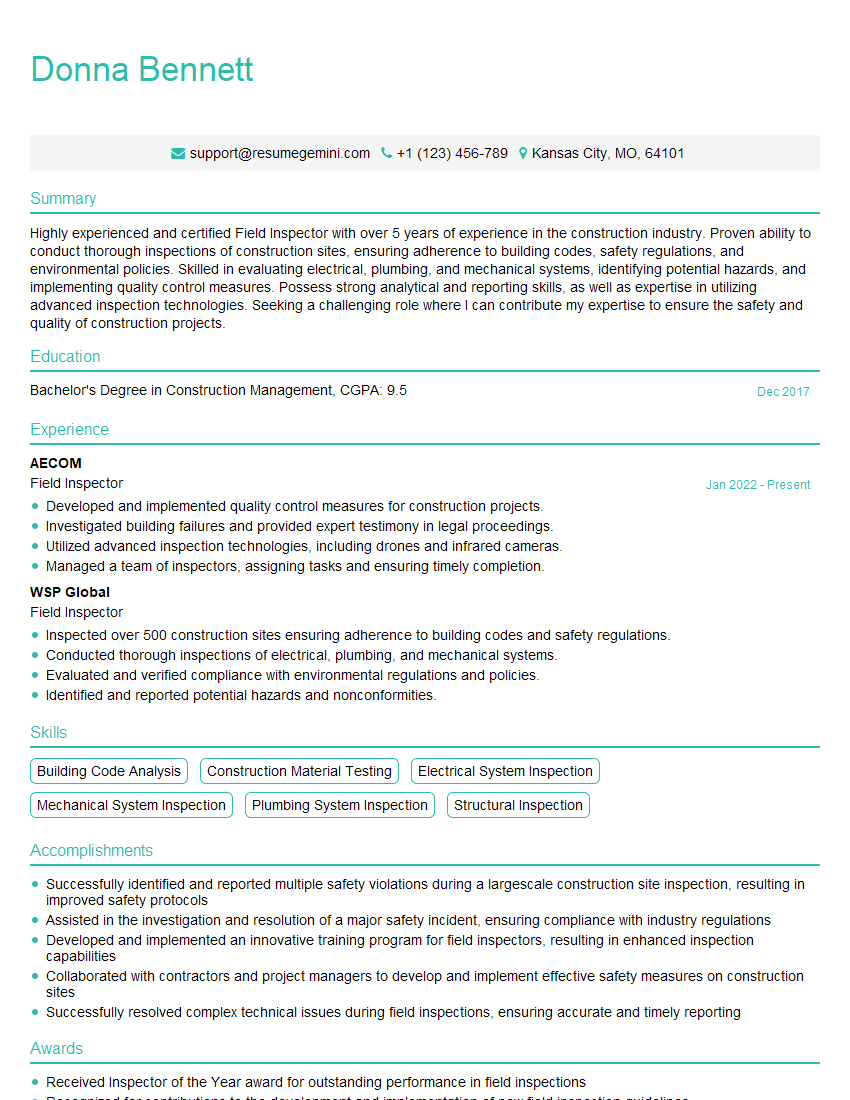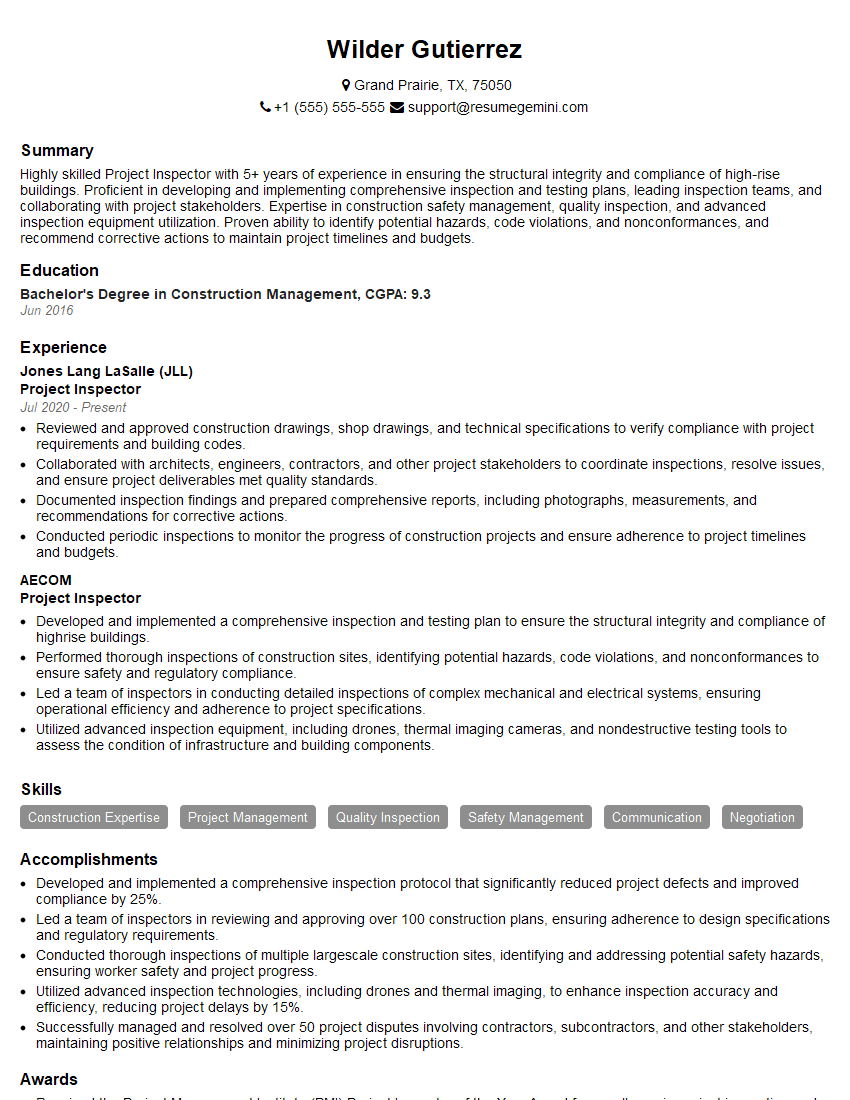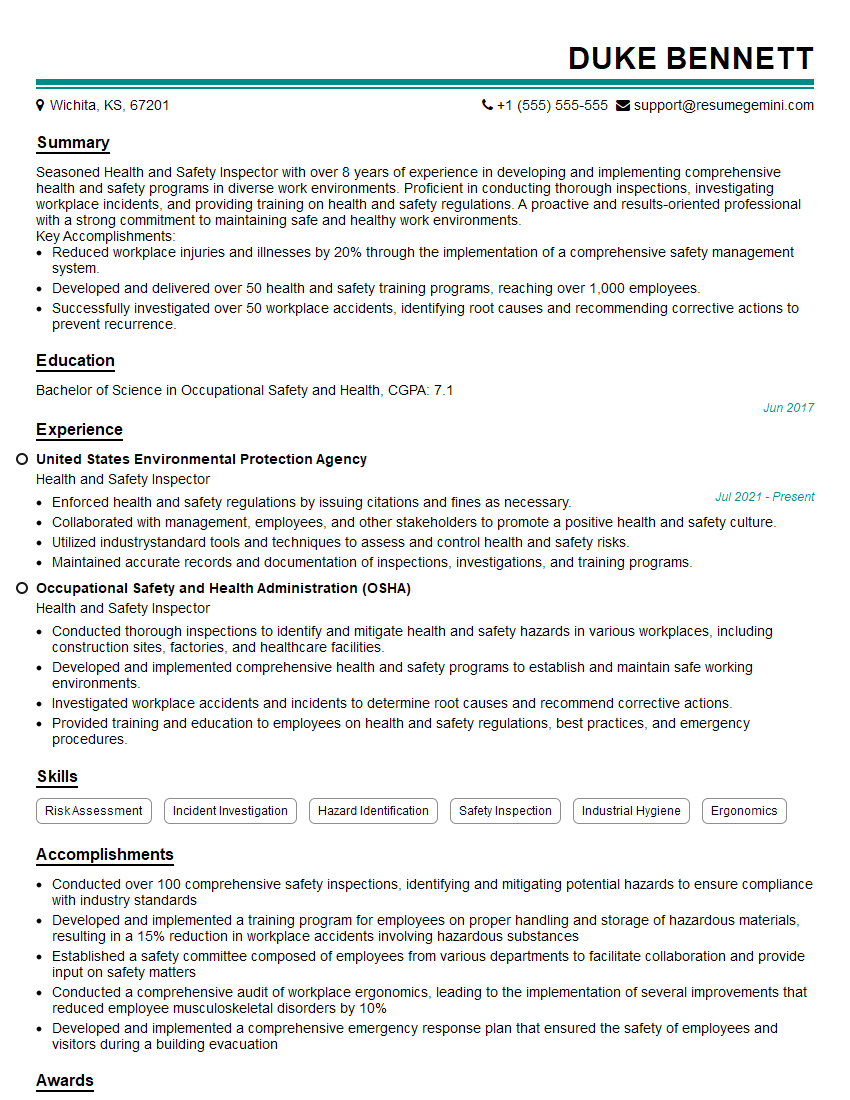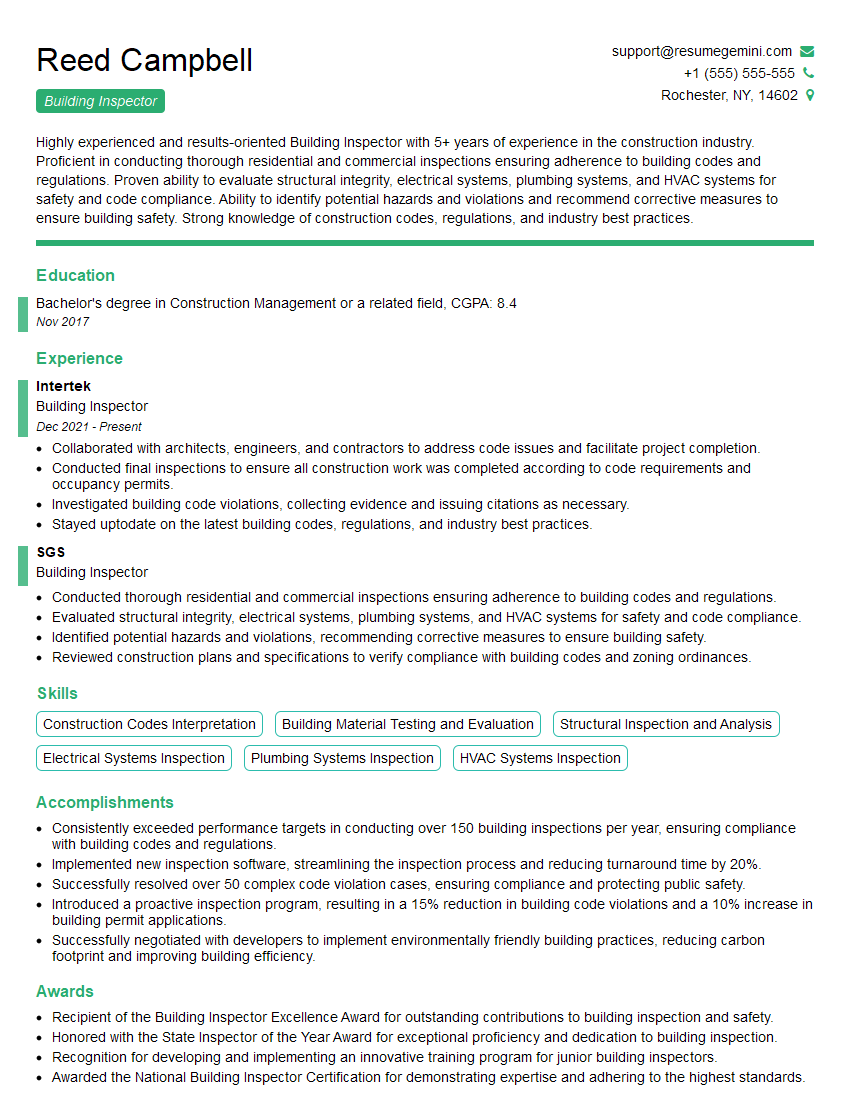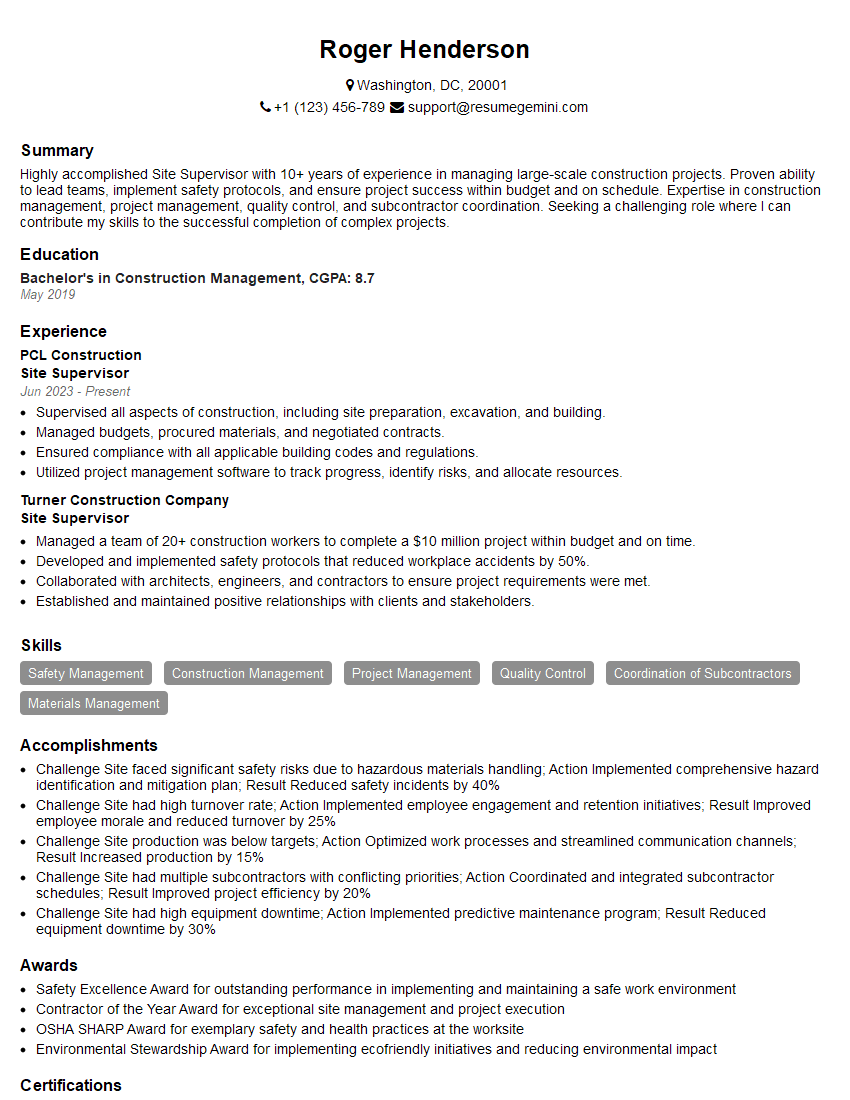The right preparation can turn an interview into an opportunity to showcase your expertise. This guide to Site Inspection and Evaluation interview questions is your ultimate resource, providing key insights and tips to help you ace your responses and stand out as a top candidate.
Questions Asked in Site Inspection and Evaluation Interview
Q 1. Describe your experience with different types of site inspections.
My experience encompasses a wide range of site inspections, from initial site assessments for feasibility studies to regular progress inspections during construction, and final inspections before project handover. I’ve worked on diverse projects including residential, commercial, and industrial builds, each demanding a unique approach. For instance, a pre-construction site assessment focuses on soil conditions, utilities access, and potential environmental hazards. During construction, inspections focus on adherence to building codes, quality of materials, and overall workmanship. Final inspections are thorough checks for completion, compliance, and functionality. I’ve also conducted specialized inspections, such as those for fire safety, accessibility compliance, and structural integrity, often involving the use of specialized equipment and collaborating with sub-consultants.
- Pre-construction Inspections: These assess site suitability, identifying potential risks and opportunities. An example would be identifying unsuitable soil requiring specialized foundation design.
- During Construction Inspections: These monitor progress, ensure quality, and identify deviations from plans and specifications. For example, verifying the correct concrete mix design or ensuring proper installation of electrical conduits.
- Final Inspections: These verify the project’s completion, compliance with regulations, and overall functionality. This might involve testing HVAC systems or checking for water leaks.
Q 2. How do you prioritize inspection tasks on a large project?
Prioritizing tasks on a large project requires a structured approach. I typically employ a risk-based prioritization system. This involves identifying potential risks and their severity, and assigning priorities accordingly. For example, safety-related issues are always prioritized over aesthetic concerns. I use a combination of checklists, project schedules, and risk assessments to create a prioritized inspection schedule. Critical path activities that might delay the project are given precedence. I also consider the stage of construction; for instance, early inspections might focus on foundation work, while later inspections will focus on finishing and systems integration. This systematic approach ensures that resources are allocated efficiently and that high-priority issues are addressed promptly.
Imagine a large hospital construction – structural integrity checks take precedence over paint color verification. Utilizing a software like Primavera P6 for scheduling helps in syncing inspection priorities with the overall project schedule.
Q 3. Explain your process for documenting inspection findings.
My documentation process is comprehensive and meticulously detailed. I use a combination of digital and physical methods. Each inspection generates a detailed report containing: photographs and videos, detailed descriptions of findings including measurements and specific locations, reference to relevant drawings and specifications, and a clear classification of each finding as a deficiency, non-conformity, or observation. For example, if a crack is found in a wall, I record its length, width, location, potential cause, and recommended remedial action. All documentation is timestamped and linked to specific locations on the project site using GPS coordinates or building plans. I use software to generate organized reports, ensuring traceability and easy access for all stakeholders.
For example, a picture showing a cracked foundation wall will be paired with notes about its location, size, and my recommended course of action. These notes are referenced with the building’s blueprints to easily pinpoint the location.
Q 4. What software or tools do you use for site inspection and reporting?
I utilize a variety of software and tools to streamline my workflow. For documentation, I use dedicated inspection apps like PlanGrid or Procore, which allow for real-time data entry, photo and video uploads, and automated report generation. These apps also provide a centralized platform for communication and collaboration with the project team. I also use drone technology for aerial inspections, providing a comprehensive overview of large sites, especially helpful in identifying potential issues such as roof leaks or uneven grading. Furthermore, I use measuring tools like laser distance meters and 3D scanners to precisely document dimensions and conditions, particularly crucial for complex structural inspections.
For instance, Procore allows uploading images directly to specific items on a project’s drawing. This allows for easy cross-referencing and quick identification of an issue.
Q 5. How do you handle discrepancies or conflicts between inspection findings and project plans?
Discrepancies between inspection findings and project plans require careful investigation and resolution. The first step is verifying the accuracy of both the inspection findings and the plans themselves. This may involve re-measuring, reviewing shop drawings, and consulting with the design team or other relevant experts. If a discrepancy is confirmed, I document it thoroughly and propose a resolution. This might involve issuing a change order, requesting clarification from the design team, or suggesting alternative solutions based on the project specifications. The decision-making process involves discussion with the project manager and other stakeholders. The goal is to find a solution that is safe, cost-effective, and in line with the project goals.
For example, If an inspection reveals a deviation from the specified material, I will document it, and we would decide whether to replace the material or proceed with a revised plan, after discussing potential impacts.
Q 6. What safety protocols do you strictly adhere to during site inspections?
Safety is paramount in all my site inspections. I strictly adhere to all relevant safety regulations and guidelines, including wearing appropriate personal protective equipment (PPE) such as hard hats, safety glasses, high-visibility clothing, and safety footwear. Before entering a site, I assess potential hazards and plan a safe route. I am always aware of my surroundings and the activities happening around me. I communicate with site personnel to ensure they are aware of my presence and to avoid potential collisions or accidents. I also make sure all machinery is operated safely and that appropriate safety precautions are in place before conducting any inspections. I will not proceed with an inspection if there are unsafe conditions.
For instance, on a construction site, I would never enter an area without confirming the appropriate safety measures are in place, such as fall protection or traffic management.
Q 7. How do you communicate inspection results effectively to stakeholders?
Effective communication is critical in ensuring that inspection results are understood and acted upon. I utilize a multi-pronged approach to disseminate information. Formal reports are prepared using the previously mentioned software and distributed to relevant stakeholders via email. These reports clearly outline findings, recommendations, and deadlines for corrective actions. I also hold regular meetings with project managers and contractors to discuss critical findings and to facilitate collaborative problem-solving. Informal updates are also provided as needed using instant messaging or phone calls, especially regarding urgent or time-sensitive issues. Visual aids such as photos and videos are incorporated in reports and presentations to enhance clarity and understanding.
For example, a quick phone call might be needed to alert the contractor to an immediate safety concern, while a formal report might be sent for a less urgent, but still important, issue like a minor discrepancy in finishing.
Q 8. Describe a time you identified a critical safety hazard during a site inspection.
During a site inspection at a construction site for a new high-rise building, I identified a critical safety hazard involving improperly secured scaffolding. The scaffolding was erected next to a busy thoroughfare, and several planks were loose, showing signs of significant wear and tear. This posed a serious risk of collapse, potentially causing injury or death to workers or pedestrians.
My immediate action was to halt work in the immediate vicinity and report the issue to the site supervisor immediately. I documented the hazard with photographs and detailed notes, including the location, the extent of the damage, and the potential consequences. Then, I collaborated with the site supervisor to develop an immediate action plan which included removing the compromised scaffolding and implementing a more robust safety protocol. The scaffolding was fully inspected by a qualified engineer before any further work commenced. This proactive approach ensured the safety of those working on the site and prevented a potential catastrophe.
Q 9. How do you manage your time effectively during site inspections?
Effective time management during site inspections is crucial. I utilize a structured approach incorporating several key strategies. Prior to the inspection, I thoroughly review all relevant documents, including blueprints, permits, and previous inspection reports. This preparatory work helps prioritize areas needing closer examination. On-site, I follow a pre-planned route, systematically checking off items on my checklist. I also employ time-blocking techniques, allocating specific durations to different aspects of the inspection. This prevents me from getting bogged down in one area at the expense of others. Furthermore, I utilize technology where appropriate, employing mobile devices and digital reporting tools to streamline data collection and minimize paperwork. Regular communication with the project team helps address any unexpected delays or issues, keeping the inspection process on track.
Q 10. Explain your experience with different types of inspection equipment.
My experience encompasses a wide range of inspection equipment, from basic tools like measuring tapes, levels, and moisture meters to more specialized instruments. I’m proficient in using laser distance meters for precise measurements and thermal imaging cameras to detect hidden problems such as insulation deficiencies or water leaks. I have extensive experience using drones equipped with high-resolution cameras for comprehensive aerial inspections, particularly in large-scale projects or areas difficult to access from ground level. I also utilize specialized software to analyze data collected from these devices, creating comprehensive reports and visualizations. My experience extends to using non-destructive testing (NDT) equipment, such as ultrasonic flaw detectors for assessing the integrity of concrete structures. Safety is paramount and I am always well versed in the safe and proper use of all the equipment I utilize.
Q 11. How do you ensure the accuracy and completeness of your inspection reports?
Accuracy and completeness are paramount in my inspection reports. I employ a multi-step process to ensure this. First, all observations are meticulously documented during the inspection. I utilize checklists and forms to ensure consistency and completeness and I take numerous high-quality photographs and videos as visual evidence. After the inspection, I carefully review all collected data, cross-referencing information from different sources and verifying measurements. Any ambiguities are clarified before finalizing the report. The report itself follows a standardized format, outlining findings clearly and concisely, using both descriptive text and visual aids. Finally, before submission, the report undergoes a thorough review process to detect any omissions or errors, ensuring accuracy and clarity. This rigorous approach guarantees the credibility and reliability of my findings.
Q 12. How familiar are you with relevant building codes and regulations?
I possess a thorough understanding of relevant building codes and regulations, including the International Building Code (IBC), local ordinances, and other applicable standards. My knowledge extends to accessibility regulations such as the Americans with Disabilities Act (ADA) and environmental regulations related to construction and demolition. I regularly update my knowledge through professional development courses, workshops, and review of updated code publications. This ongoing learning ensures that my inspections adhere to the most current standards. I can effectively identify code violations and provide detailed recommendations for compliance during my inspections.
Q 13. Describe your experience with using checklists and inspection forms.
Checklists and inspection forms are indispensable tools in my work. I utilize customized forms tailored to the specific type of inspection being conducted, ensuring all relevant aspects are covered. These forms provide a systematic approach to data collection, enhancing the efficiency and thoroughness of the inspection. Using a digital format allows for easy data entry, storage, and retrieval. This reduces time spent on manual data entry and facilitates quick report generation. Data collected through the checklists and forms feeds directly into the inspection report, ensuring consistency and reducing the risk of omissions. The digital approach also facilitates the sharing of information amongst relevant stakeholders.
Q 14. How do you handle challenging or difficult situations on site?
Challenging situations can arise on site, such as disagreements with contractors, unexpected discoveries, or hostile weather conditions. My approach centers on professional communication and problem-solving. In situations of conflict, I strive to maintain a neutral and objective stance, focusing on facts and evidence. I clearly articulate concerns, explaining the safety implications or code violations without judgment. I actively seek collaborative solutions, working with all parties involved to find mutually acceptable outcomes. If a resolution cannot be reached on-site, I will document the disagreement fully and escalate it through the appropriate channels, using written reports and other formal documentation to maintain transparency and accountability.
Q 15. What is your experience with different types of construction materials?
My experience encompasses a wide range of construction materials, from traditional materials like concrete, steel, and timber to more modern options such as composite materials, high-performance concrete, and sustainable building products. I understand the properties of each, including their strengths, weaknesses, and potential failure modes. For instance, I’ve worked on projects utilizing pre-stressed concrete, where understanding the tensioning process and potential cracking is critical for a safe and sound structure. Similarly, my experience with timber includes recognizing different species, their susceptibility to rot and insect infestation, and proper treatment methods. I’m familiar with the latest advancements in materials science and how these innovations impact structural integrity and durability, including the use of recycled materials and innovative techniques to reduce environmental impact.
Understanding material properties is crucial in site inspections. For example, identifying signs of corrosion on steel reinforcement in concrete structures, or detecting early signs of wood decay, allows for proactive measures to prevent structural issues and ensure safety.
Career Expert Tips:
- Ace those interviews! Prepare effectively by reviewing the Top 50 Most Common Interview Questions on ResumeGemini.
- Navigate your job search with confidence! Explore a wide range of Career Tips on ResumeGemini. Learn about common challenges and recommendations to overcome them.
- Craft the perfect resume! Master the Art of Resume Writing with ResumeGemini’s guide. Showcase your unique qualifications and achievements effectively.
- Don’t miss out on holiday savings! Build your dream resume with ResumeGemini’s ATS optimized templates.
Q 16. Describe your experience with reviewing blueprints and specifications.
Reviewing blueprints and specifications is a fundamental part of my process. I’m proficient in interpreting architectural, structural, mechanical, electrical, and plumbing (MEP) drawings. This includes understanding the design intent, verifying compliance with building codes and regulations, and identifying potential conflicts or discrepancies. I’m adept at using various software programs to view and analyze these documents, including Autodesk AutoCAD and Revit. My process typically includes a thorough review of the specifications document to understand the required materials, workmanship standards, and testing procedures. This allows me to effectively compare the as-built conditions with the design intent during the site inspection.
For example, I once identified a discrepancy between the structural drawings and the specifications regarding the type of concrete specified for a particular foundation wall. This seemingly minor detail could have led to significant structural issues if not identified early on. My familiarity with these documents ensures the project adheres to the approved design and minimizes the risks of defects.
Q 17. How do you maintain objectivity during site inspections?
Maintaining objectivity is paramount. I approach each inspection with a structured methodology, utilizing checklists and standardized procedures to ensure a consistent and unbiased assessment. This includes documenting findings meticulously, using photos and videos to support observations. I also strive to avoid preconceived notions or biases, focusing solely on factual data gathered during the inspection. It’s crucial to separate personal opinions from factual observations. Regular calibration with industry standards and peer reviews helps maintain objectivity and ensure consistent quality of work.
For example, if I observe a deviation from the specifications, I document it with photographic evidence and present it factually, avoiding judgmental language. I simply state the observation and let the relevant stakeholders interpret the significance based on their expertise and experience.
Q 18. How do you ensure the confidentiality of information obtained during inspections?
Confidentiality is a critical aspect of my work. I adhere to strict professional ethics and confidentiality agreements. All information gathered during inspections is treated as strictly confidential and is only shared with authorized personnel on a need-to-know basis. I avoid discussing sensitive information in public areas or with unauthorized individuals. All reports and documentation are secured using appropriate access control measures, and I follow my company’s data protection policies.
For example, when dealing with sensitive information like financial details related to cost overruns or specific proprietary technology incorporated in the project, I ensure this information is only disclosed to authorized parties and handled with utmost discretion. I believe client trust is built on protecting sensitive data.
Q 19. What is your experience with using digital photography and videography for documentation?
I have extensive experience using digital photography and videography to document inspection findings. I utilize high-resolution cameras and drones to capture comprehensive visual records of the site conditions, including close-up shots of defects, overall views of the project progress, and three-dimensional representations of the site. The data is properly labeled and organized for easy retrieval and use in reports. I use video footage to showcase dynamic aspects, like equipment operation or structural movement.
This technology is essential for creating detailed, accurate, and easily understood reports. Visual documentation provides irrefutable evidence of site conditions and facilitates clear communication between stakeholders.
Q 20. How do you stay updated on industry best practices and new technologies?
Staying current with industry best practices and new technologies is crucial. I achieve this through ongoing professional development, including attending conferences and workshops, participating in industry associations, and actively seeking training on new inspection technologies. I regularly review industry publications, journals, and online resources to stay informed about the latest advancements in construction materials, techniques, and safety regulations.
For instance, I’ve recently completed training on the use of thermal imaging cameras to detect hidden moisture problems in buildings, a technology that enhances my ability to identify potential defects.
Q 21. Describe your experience with environmental site assessments.
My experience with environmental site assessments involves identifying and evaluating potential environmental hazards and liabilities associated with a property or construction project. This includes assessing potential contamination from past activities (e.g., hazardous waste disposal), identifying protected species or habitats, and evaluating potential impacts on air and water quality. My work incorporates the application of relevant environmental regulations, such as those related to hazardous waste management, stormwater runoff, and endangered species protection. I am familiar with various assessment methodologies and sampling techniques to ensure the evaluation is thorough and accurate.
For example, I’ve worked on projects where identifying the presence of asbestos-containing materials or lead-based paint was crucial to mitigating potential health risks and ensuring compliance with environmental regulations before demolition or renovation commenced. Environmental site assessments are vital for risk management and responsible development.
Q 22. How do you handle unexpected delays or changes during inspections?
Unexpected delays and changes are an inherent part of site inspections. My approach is proactive and flexible. I begin by establishing clear communication with all stakeholders – clients, contractors, and any relevant authorities – before the inspection even begins. This includes outlining potential contingencies and establishing clear protocols for reporting delays.
For instance, if unforeseen weather conditions threaten to postpone the inspection, I immediately inform all parties and propose alternative dates or adjust the schedule to focus on indoor assessments. If a specific area becomes inaccessible due to unforeseen circumstances, I would document the limitation, explain its impact on the overall assessment, and suggest alternative methods of gathering necessary data (like utilizing drone footage or reviewing existing documentation). A crucial part of handling unexpected situations involves detailed record-keeping; I always meticulously document any changes, delays, or limitations in my inspection report.
Q 23. What is your approach to collaborating with other professionals on site?
Collaboration is paramount in site inspections. My approach centers around clear communication, shared goals, and mutual respect. I foster a collaborative environment by actively listening to the perspectives of other professionals, whether they are engineers, architects, environmental specialists, or safety officers. I believe in establishing a common understanding of the inspection objectives at the outset.
For example, before a large-scale industrial facility inspection, I would hold a pre-inspection meeting to coordinate schedules, clarify roles, and discuss potential challenges. During the inspection itself, I use collaborative tools like shared checklists and digital platforms to ensure everyone is on the same page and can access relevant information in real-time. I actively seek input and expertise from colleagues; respecting their knowledge and leveraging their specialized perspectives to create a more comprehensive and thorough assessment.
Q 24. Explain your experience with using GIS or mapping software for site analysis.
I have extensive experience utilizing Geographic Information Systems (GIS) and mapping software for site analysis. This includes software such as ArcGIS, QGIS, and Google Earth Pro. I use these tools for various purposes including creating base maps, integrating survey data, analyzing spatial relationships between features, and generating visual representations of findings.
For instance, during a large-scale environmental site assessment, I used ArcGIS to overlay environmental data layers (soil contamination, topography, hydrology) with site features (buildings, utilities, access routes) to identify areas of potential environmental risk. This allowed me to efficiently focus on high-risk areas during the field inspection and create visually compelling maps illustrating the findings within the final report, improving the clarity and understanding of the information.
Q 25. How do you quantify the severity of inspection findings?
Quantifying the severity of inspection findings is crucial for prioritization and effective remediation. I use a standardized severity rating system, usually a four-level scale: Critical, Major, Minor, and Informational.
Critical findings pose immediate safety hazards or significant functional impairments. Major findings present substantial risks requiring prompt attention but don’t represent an immediate threat. Minor findings represent relatively small issues that may require attention but don’t pose significant risks. Informational findings document existing conditions that may not need immediate action but are important for future planning. This system ensures clarity and consistency in reporting and facilitates efficient prioritization of corrective actions. Each level is defined clearly, with specific examples provided within the inspection report to eliminate ambiguity.
Q 26. Describe your experience with root cause analysis related to inspection findings.
Root cause analysis (RCA) is essential for preventing recurrence of inspection findings. I employ various RCA techniques such as the “5 Whys,” fault tree analysis, and fishbone diagrams. The “5 Whys” method involves repeatedly asking “why” to uncover the underlying causes of a problem.
For example, if I find cracks in a building’s foundation (the problem), I would ask: Why are there cracks? (Poor foundation design). Why was the design poor? (Inadequate soil analysis). Why was the soil analysis inadequate? (Insufficient testing). Why was insufficient testing conducted? (Budget constraints). Why were there budget constraints? (Project scheduling issues). This process helps identify the root cause (project scheduling issues) and allows for the development of targeted corrective actions and preventative measures.
Q 27. How do you handle situations where remediation or corrective action is required?
When remediation or corrective action is needed, I work closely with the client and relevant stakeholders to develop a comprehensive plan. This involves clearly defining the necessary actions, establishing timelines, and allocating responsibilities. I provide detailed recommendations, often including specifications and references to relevant codes and standards.
I might also suggest qualified contractors or specialists, especially for complex issues. Following remediation, a follow-up inspection is crucial to verify the effectiveness of the corrective actions. This ensures the problem has been adequately addressed and to identify any further issues that may have arisen during the remediation process. All of this is meticulously documented to maintain a clear audit trail.
Q 28. What are your salary expectations for this role?
My salary expectations are commensurate with my experience and qualifications in site inspection and evaluation, and also align with the industry standard for professionals with similar expertise in this region. I am confident that my skills and experience will bring significant value to your organization, and I am open to discussing a competitive salary range that reflects this contribution.
Key Topics to Learn for Site Inspection and Evaluation Interview
- Safety Regulations and Compliance: Understanding and applying relevant safety regulations, codes, and best practices during site inspections. This includes identifying potential hazards and recommending corrective actions.
- Data Collection and Documentation: Mastering techniques for accurately collecting data (photographic, written, measured), meticulous record-keeping, and generating clear, concise reports summarizing findings and recommendations.
- Structural Assessment: Evaluating the structural integrity of buildings or infrastructure, identifying potential weaknesses or damage, and understanding the principles behind various construction methods.
- Environmental Considerations: Identifying potential environmental impacts, compliance with environmental regulations, and the implementation of sustainable practices during site evaluation.
- Problem-Solving and Decision-Making: Demonstrating the ability to analyze complex situations, identify root causes of problems, and propose effective solutions within budgetary and time constraints.
- Communication and Collaboration: Effectively communicating findings and recommendations to both technical and non-technical audiences, including clients, contractors, and team members.
- Technology and Tools: Proficiency with relevant software and tools used for site inspections and evaluations (e.g., surveying equipment, data analysis software).
- Risk Assessment and Mitigation: Identifying potential risks associated with the site and developing strategies to mitigate those risks.
Next Steps
Mastering Site Inspection and Evaluation is crucial for career advancement in construction, engineering, and related fields. It demonstrates a commitment to safety, accuracy, and problem-solving – highly valued attributes in today’s market. To significantly boost your job prospects, creating a strong, ATS-friendly resume is paramount. ResumeGemini offers a powerful tool to build a professional resume that highlights your skills and experience effectively. We provide examples of resumes tailored to Site Inspection and Evaluation to help you showcase your expertise. Use ResumeGemini to build a resume that truly represents your capabilities and sets you apart from the competition.
Explore more articles
Users Rating of Our Blogs
Share Your Experience
We value your feedback! Please rate our content and share your thoughts (optional).
What Readers Say About Our Blog
Hello,
We found issues with your domain’s email setup that may be sending your messages to spam or blocking them completely. InboxShield Mini shows you how to fix it in minutes — no tech skills required.
Scan your domain now for details: https://inboxshield-mini.com/
— Adam @ InboxShield Mini
Reply STOP to unsubscribe
Hi, are you owner of interviewgemini.com? What if I told you I could help you find extra time in your schedule, reconnect with leads you didn’t even realize you missed, and bring in more “I want to work with you” conversations, without increasing your ad spend or hiring a full-time employee?
All with a flexible, budget-friendly service that could easily pay for itself. Sounds good?
Would it be nice to jump on a quick 10-minute call so I can show you exactly how we make this work?
Best,
Hapei
Marketing Director
Hey, I know you’re the owner of interviewgemini.com. I’ll be quick.
Fundraising for your business is tough and time-consuming. We make it easier by guaranteeing two private investor meetings each month, for six months. No demos, no pitch events – just direct introductions to active investors matched to your startup.
If youR17;re raising, this could help you build real momentum. Want me to send more info?
Hi, I represent an SEO company that specialises in getting you AI citations and higher rankings on Google. I’d like to offer you a 100% free SEO audit for your website. Would you be interested?
Hi, I represent an SEO company that specialises in getting you AI citations and higher rankings on Google. I’d like to offer you a 100% free SEO audit for your website. Would you be interested?
good

